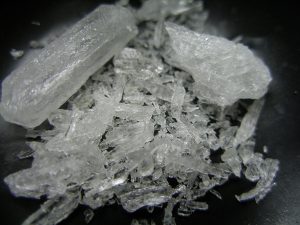Despite the economic downturn prompted by the COVID-19 pandemic, drug traffickers in East and Southeast Asia have found ways to expand and diversify, pushing production of some synthetic drugs to an all-time high.
In its annual report on the Asia synthetic drug market, the U.N. Office of Drugs and Crime (UNODC) noted that the production of synthetic drugs expanded across the region in 2020, driven especially by the surging production of methamphetamine, the region’s most popular drug.
Asian anti-drug authorities confiscated a record of almost 170 tons of meth last year, up 19 percent from 2019, the report said, and more than double the 82.5 tons seized in 2017.
According to the report, which was released yesterday, meth production suffered a short-lived disruption in the second quarter of 2020, as the pandemic reached its first peak, but then quickly rebounded, “demonstrating the flexibility of organized crime groups to adapt to change and take advantage of porous borders in the region.”
“While the pandemic has caused the global economy to slow down, criminal syndicates that dominate the region have quickly adapted and capitalized,” Jeremy Douglas, UNODC’s Regional Representative for Southeast Asia and the Pacific, told Reuters.
According to the report, the continued growth was “in part attributable to the ease with which organized crime has been able to diversify the locations of manufacture, and obtain controlled precursors as well as an increasingly wide range of non-controlled chemicals.” The supply of synthetic drugs such as ecstasy, cannabinoids, and ketamine has also expanded across the region, the report said.
Because of this glut in supply, wholesale prices of crystalline methamphetamine have dropped to record lows in countries like Cambodia, Malaysia, and Thailand, the report stated, “which contributes to increasing demand and use in the region.”
The lion’s share of the illegal drug production continued to take place in Myanmar’s Shan State, where a mix of rugged terrain, fractured state jurisdictions, and proximity to China and Southeast Asian drug and precursor markets has long provided the ideal conditions for illicit drug production.
Over the past two decades, meth production has jumped up in Myanmar, particularly in Shan State, displacing the opium and heroin production that once predominated in the region. Notably, production in Myanmar appears to have been little affected by the political crisis that has followed the military’s seizure of power on February 1. Indeed, the UNODC has predicted that the country’s drug syndicates are set to thrive on the chaos unleashed by the military coup.
In an effort to dodge COVID-19 movement restrictions, criminal groups in Myanmar diversified their transport routes. Particularly, it noted increased shipments of drugs through Laos, which has relatively weak law enforcement capacity and borders a region of Shan State that contains known smuggling routes.
The report also noted Cambodia’s emergence as a large-scale source for methamphetamine production. Based on growing seizures of precursor chemicals and shutdowns of synthetic drug labs, UNODC suggested that “organized crime groups have increasingly targeted Cambodia to diversify their methamphetamine supply channels.”































